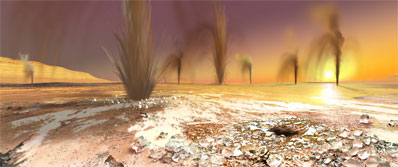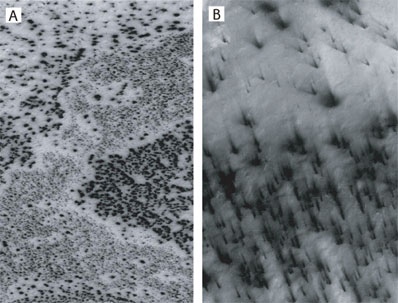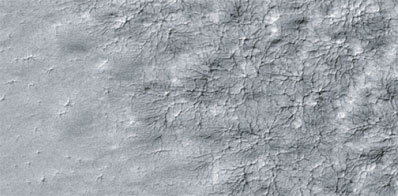
Spaceflight Now +

|

|

|

|

Premium video content for our Spaceflight Now Plus subscribers.

STS-31: Opening window to the Universe
 The Hubble Space Telescope has become astronomy's crown jewel for knowledge and discovery. The great observatory was placed high above Earth following its launch aboard space shuttle Discovery on April 24, 1990. The astronauts of STS-31 recount their mission in this post-flight film presentation. The Hubble Space Telescope has become astronomy's crown jewel for knowledge and discovery. The great observatory was placed high above Earth following its launch aboard space shuttle Discovery on April 24, 1990. The astronauts of STS-31 recount their mission in this post-flight film presentation.

 Small | Medium | Large Small | Medium | Large

Atlantis on the pad
 Space shuttle Atlantis is delivered to Kennedy Space Center's launch pad 39B on August 2 to begin final preparations for blastoff on the STS-115 mission to resume construction of the International Space Station. Space shuttle Atlantis is delivered to Kennedy Space Center's launch pad 39B on August 2 to begin final preparations for blastoff on the STS-115 mission to resume construction of the International Space Station.

 PLAY PLAY

Atlantis rollout begins
 Just after 1 a.m. local time August 2, the crawler-transporter began the slow move out of the Vehicle Assembly Building carrying space shuttle Atlantis toward the launch pad. Just after 1 a.m. local time August 2, the crawler-transporter began the slow move out of the Vehicle Assembly Building carrying space shuttle Atlantis toward the launch pad.

 PLAY PLAY

ISS EVA preview
 Astronauts Jeff Williams and Thomas Reiter will conduct a U.S.-based spacewalk outside the International Space Station on August 3. To preview the EVA and the tasks to be accomplished during the excursion, station managers held this press conference from Johnson Space Center in Houston. Astronauts Jeff Williams and Thomas Reiter will conduct a U.S.-based spacewalk outside the International Space Station on August 3. To preview the EVA and the tasks to be accomplished during the excursion, station managers held this press conference from Johnson Space Center in Houston.

 Dial-up | Broadband Dial-up | Broadband

STS-34: Galileo launch
 The long voyage of exploration to Jupiter and its many moons by the Galileo spacecraft began on October 18, 1989 with launch from Kennedy Space Center aboard the space shuttle Atlantis. The crew of mission STS-34 tell the story of their flight to dispatch the probe -- fitted with an Inertial Upper Stage rocket motor -- during this post-flight presentation film. The long voyage of exploration to Jupiter and its many moons by the Galileo spacecraft began on October 18, 1989 with launch from Kennedy Space Center aboard the space shuttle Atlantis. The crew of mission STS-34 tell the story of their flight to dispatch the probe -- fitted with an Inertial Upper Stage rocket motor -- during this post-flight presentation film.

 Small | Medium | Large Small | Medium | Large

Atlantis on the move
 Space shuttle Atlantis is transported to the cavernous Vehicle Assembly Building where the ship will be mated to the external fuel tank and twin solid rocket boosters for a late-August liftoff. Space shuttle Atlantis is transported to the cavernous Vehicle Assembly Building where the ship will be mated to the external fuel tank and twin solid rocket boosters for a late-August liftoff.

 PLAY | TIME-LAPSE PLAY | TIME-LAPSE

Discovery ride along!
 A camera was mounted in the front of space shuttle Discovery's flight deck looking back at the astronauts during launch. This video shows the final minutes of the countdown and the ride to space with the live launch audio included. The movie shows what it would be like to launch on the shuttle with the STS-121 crew. A camera was mounted in the front of space shuttle Discovery's flight deck looking back at the astronauts during launch. This video shows the final minutes of the countdown and the ride to space with the live launch audio included. The movie shows what it would be like to launch on the shuttle with the STS-121 crew.

 PLAY PLAY

Shuttle from the air
 A high-altitude WB-57 aircraft flying north of Discovery's launch trajectory captures this incredible aerial footage of the space shuttle's ascent from liftoff through solid rocket booster separation. A high-altitude WB-57 aircraft flying north of Discovery's launch trajectory captures this incredible aerial footage of the space shuttle's ascent from liftoff through solid rocket booster separation.

 PLAY PLAY

Launch experience
 This is the full launch experience! The movie begins with the final readiness polls of the launch team. Countdown clocks then resume ticking from the T-minus 9 minute mark, smoothly proceeding to ignition at 2:38 p.m. Discovery rockets into orbit, as seen by ground tracker and a video camera mounted on the external tank. About 9 minutes after liftoff, the engines shut down and the tank is jettisoned as the shuttle arrives in space. This is the full launch experience! The movie begins with the final readiness polls of the launch team. Countdown clocks then resume ticking from the T-minus 9 minute mark, smoothly proceeding to ignition at 2:38 p.m. Discovery rockets into orbit, as seen by ground tracker and a video camera mounted on the external tank. About 9 minutes after liftoff, the engines shut down and the tank is jettisoned as the shuttle arrives in space.

 PLAY PLAY

Delta 2 launches MiTEx
 MiTEx -- an experimental U.S. military project to test whether the advanced technologies embedded in two miniature satellites and a new upper stage kick motor can operate through the rigors of spaceflight -- is launched from Cape Canaveral aboard a Boeing Delta 2 rocket. MiTEx -- an experimental U.S. military project to test whether the advanced technologies embedded in two miniature satellites and a new upper stage kick motor can operate through the rigors of spaceflight -- is launched from Cape Canaveral aboard a Boeing Delta 2 rocket.

 Full coverage Full coverage

 Become a subscriber Become a subscriber
 More video More video

|

|

|

|
|

|

Gas jets spawn dark 'spiders' and spots on Mars icecap
ARIZONA STATE UNIVERSITY NEWS RELEASE
Posted: August 16, 2006
Every spring it happens. As the Sun peeks above the horizon at the Martian south polar icecap, powerful jets of carbon-dioxide (CO2) gas erupt through the icecap's topmost layer. The jets climb high into the thin, cold air, carrying fine, dark sand and spraying it for hundreds of feet around each jet.

Sand-laden jets shoot into the polar sky in this view by noted space artist Ron Miller. It shows the Martian south polar icecap as southern spring begins. Credit: Arizona State University/Ron Miller
Download larger image version here
|
This dramatic scene emerges from new research by a team of Mars scientists
that includes Arizona State University's Phil Christensen. The research
report, co-authored with Hugh Kieffer (U.S. Geological Survey, retired)
and Timothy Titus (USGS), appears in August 17, 2006 issue of the
scientific journal "Nature." The new work solves a longstanding Martian
polar riddle.
"If you were there," says Christensen, "you'd be standing on a slab of
carbon-dioxide ice." Looking down, you would see dark ground below the
3-foot-thick ice layer. "All around you, roaring jets of CO2 gas are
throwing sand and dust a couple hundred feet into the air."
You'd also feel vibration through your spacesuit boots, he says. "The ice
slab you're standing on is levitated above the ground by the pressure of
gas at the base of the ice."
Mystery Markings
The team began its research in an attempt to explain what caused
mysterious dark spots, fan-like markings, and spider-shaped features on
the icecap at the Martian south pole. The dark spots, typically 50 to 150
feet wide and spaced several hundred feet apart, appear every southern
spring as the Sun rises over the icecap. They last for three or four
months and then vanish - only to reappear the next year, after winter's
cold has deposited a fresh layer of ice on the cap. Most spots even seem
to recur at the same locations.

Dark spots (left) and fans scribble dusty hieroglyphics on top of the Martian south polar cap in two high-resolution MOC images taken in southern spring. Each image is about 2 miles wide. Credit: NASA/JPL/MSSS
|
"Originally, scientists thought the spots were patches of warm, bare
ground exposed as the ice disappeared," notes Christensen. "But
observations made with THEMIS on NASA's Mars Odyssey orbiter told us the
spots were nearly as cold as the CO2 ice, which is at -198 deg Fahrenheit."
That finding suggested the spots were just a thin layer of dark material
lying on top of the ice and kept chilled by it.
THEMIS is the Thermal Emission Imaging System, a multi-wavelength camera.
Christensen, who is a Regents' Professor of Geological Sciences at ASU's
new School of Earth and Space Exploration in the College of Liberal Arts
and Sciences, designed THEMIS and is the instrument's principal
investigator. The new school houses ASU's renowned Mars Space Flight
Facility.
Using more than 200 THEMIS visible and infrared images, the team studied
one area on the icecap, at 99 deg east longitude and 86.3 deg south latitude,
from the end of southern winter through mid-summer. The spots began to
appear when the Sun was only half a degree high, then quickly became more
numerous over several days.
"A few places remained spot-free for more than 100 days," notes
Christensen. "Then they developed a large number in a week."
The scientists saw that fan-shaped dark markings didn't form until days or
weeks after the spots first appeared, yet some fans grew to half a mile in
length. Even more puzzling was the origin of the "spiders," grooves eroded
into the surface under the ice. The grooves converge at points directly
beneath a spot.
Icy Greenhouse
"The key to figuring out the spiders and the spots," says Christensen,
"was thinking through a physical model for what was happening." The whole
process, he explains, begins during Mars' frigid Antarctic winter, when
temperatures drop to -200 deg F. That's so cold that the Martian air - 95
percent carbon dioxide - freezes out directly onto the surface of the
permanent polar cap, which is made of water ice covered with layers of
dust and sand.
This seasonal deposit begins as a layer of dusty CO2 frost. Over the
winter, the frost recrystalizes and becomes denser, a process called
annealing. The dust and sand particles caught in the frost slowly sink. By
spring, with the Sun about to rise, the frost layer has become a slab of
semi-transparent ice about 3 feet thick, lying on a substrate of dark sand
and dust.
Sunlight passing through the slab reaches the dark material and warms it
enough that the ice touching the ground sublimates - it turns directly
into gas. As days pass and the Sun rises higher, sublimation continues.
Before long, the warmed substrate generates a reservoir of pressurized gas
under the slab, lifting it off the ground.
Big Blowout
Soon after, weak spots in the slab break through, forming narrow vents,
and high-pressure gas roars out at speeds of 100 miles per hour or more.
Under the slab, the gas erodes the ground as it rushes toward the vents,
snatching up loose particles of sand and carving networks of grooves that
converge on the vents.

Spiders trace a delicate pattern on top of the residual polar cap, after the seasonal carbon-dioxide ice slab has disappeared. Next spring, these will likely mark the sites of vents when the CO2 icecap returns. This MOC image is about 2 miles wide. Credit: NASA/JPL/MSSS
|
"Once a spider becomes established," says Christensen, "it affects the
surface so that a vent will form in the same place the following year."
As they erupt, the jets carry loose sand and particles high in the air.
The largest and heaviest particles fall closest to the vent, piling up
around it to make the spots. As lighter sand grains tossed out by the jet
blow downwind, they create the fans, which can extend tens to hundreds of
yards. The lightest particles, meanwhile, drift away on the wind to form a
thin layer of dust.
"It's like separating wheat and chaff," explains Christensen. "The
finest-grained materials are carried off by the wind, while coarser grains
are sifted again and again, year after year."
The vents and jets continue to erupt until the ice slab completely
sublimates and vanishes.
This mechanism, says Christensen, "is unlike anything that occurs on Earth."
|

|

|

|


|



